An official website of the United States government
 United States Department of Labor
United States Department of Labor
Administer anesthetics and analgesics for pain management prior to, during, or after surgery.
Employment estimate and mean wage estimates for Anesthesiologists:
| Employment (1) | Employment RSE (3) |
Mean hourly wage |
Mean annual wage (2) |
Wage RSE (3) |
|---|---|---|---|---|
| 28,590 | 5.9 % | $ 130.50 | $ 271,440 | 1.9 % |
Percentile wage estimates for Anesthesiologists:
| Percentile | 10% | 25% | 50% (Median) |
75% | 90% |
|---|---|---|---|---|---|
| Hourly Wage | $ 65.47 | (5) | (5) | (5) | (5) |
| Annual Wage (2) | $ 136,180 | (5) | (5) | (5) | (5) |
Industries with the highest published employment and wages for Anesthesiologists are provided. For a list of all industries with employment in Anesthesiologists, see the Create Customized Tables function.
Industries with the highest levels of employment in Anesthesiologists:
| Industry | Employment (1) | Percent of industry employment | Hourly mean wage | Annual mean wage (2) |
|---|---|---|---|---|
| Offices of Physicians | 23,120 | 0.89 | $ 136.19 | $ 283,280 |
| General Medical and Surgical Hospitals | 3,920 | 0.07 | $ 107.01 | $ 222,580 |
| Outpatient Care Centers | 560 | 0.06 | (5) | (5) |
| Colleges, Universities, and Professional Schools | 430 | 0.01 | $ 45.82 | $ 95,300 |
| Specialty (except Psychiatric and Substance Abuse) Hospitals | 280 | 0.10 | $ 133.87 | $ 278,460 |
Industries with the highest concentration of employment in Anesthesiologists:
| Industry | Employment (1) | Percent of industry employment | Hourly mean wage | Annual mean wage (2) |
|---|---|---|---|---|
| Offices of Physicians | 23,120 | 0.89 | $ 136.19 | $ 283,280 |
| Specialty (except Psychiatric and Substance Abuse) Hospitals | 280 | 0.10 | $ 133.87 | $ 278,460 |
| General Medical and Surgical Hospitals | 3,920 | 0.07 | $ 107.01 | $ 222,580 |
| Outpatient Care Centers | 560 | 0.06 | (5) | (5) |
| Offices of Other Health Practitioners | 180 | 0.02 | $ 78.51 | $ 163,310 |
Top paying industries for Anesthesiologists:
| Industry | Employment (1) | Percent of industry employment | Hourly mean wage | Annual mean wage (2) |
|---|---|---|---|---|
| Outpatient Care Centers | 560 | 0.06 | (5) | (5) |
| Offices of Physicians | 23,120 | 0.89 | $ 136.19 | $ 283,280 |
| Specialty (except Psychiatric and Substance Abuse) Hospitals | 280 | 0.10 | $ 133.87 | $ 278,460 |
| General Medical and Surgical Hospitals | 3,920 | 0.07 | $ 107.01 | $ 222,580 |
| Offices of Other Health Practitioners | 180 | 0.02 | $ 78.51 | $ 163,310 |
States and areas with the highest published employment, location quotients, and wages for Anesthesiologists are provided. For a list of all areas with employment in Anesthesiologists, see the Create Customized Tables function.
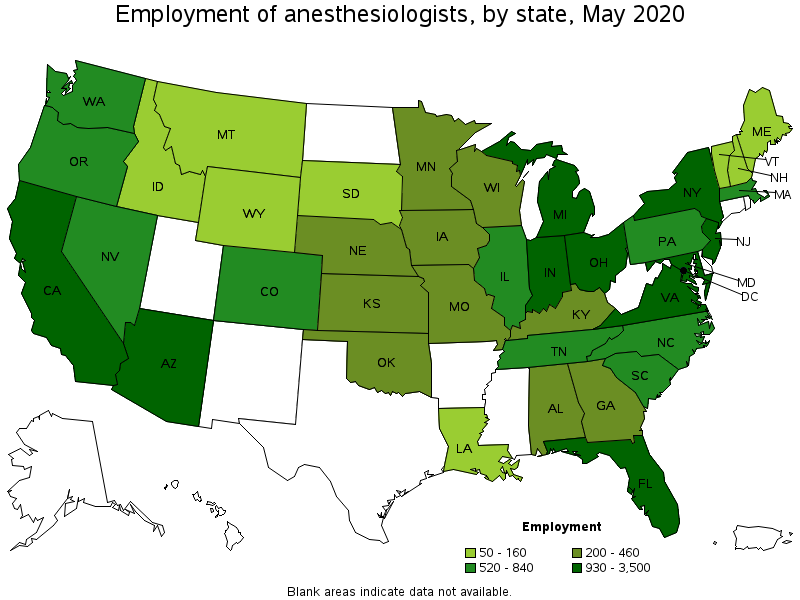
States with the highest employment level in Anesthesiologists:
| State | Employment (1) | Employment per thousand jobs | Location quotient (9) | Hourly mean wage | Annual mean wage (2) |
|---|---|---|---|---|---|
| California | 3,500 | 0.21 | 1.04 | (5) | (5) |
| New York | 2,260 | 0.26 | 1.26 | $ 114.12 | $ 237,380 |
| Florida | 1,550 | 0.18 | 0.89 | (5) | (5) |
| Virginia | 1,190 | 0.32 | 1.57 | $ 121.71 | $ 253,150 |
| Ohio | 1,190 | 0.23 | 1.13 | (5) | (5) |
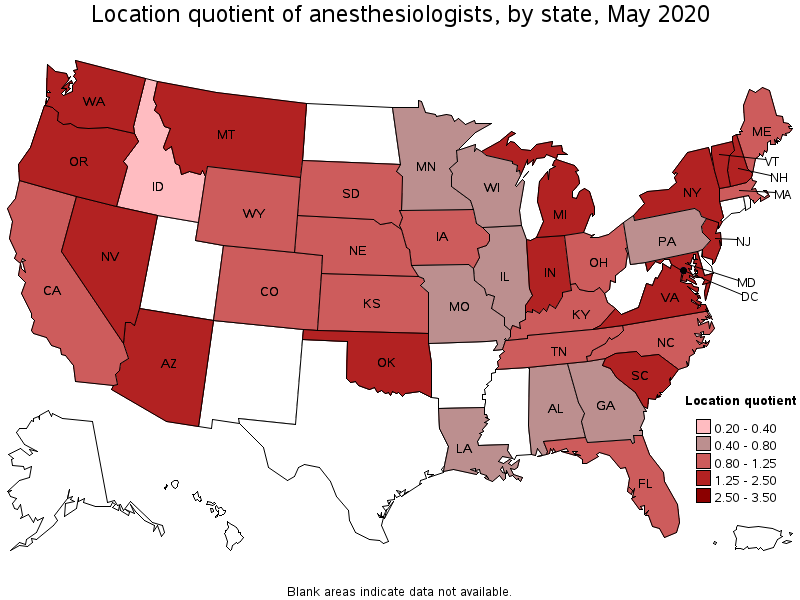
States with the highest concentration of jobs and location quotients in Anesthesiologists:
| State | Employment (1) | Employment per thousand jobs | Location quotient (9) | Hourly mean wage | Annual mean wage (2) |
|---|---|---|---|---|---|
| Nevada | 520 | 0.41 | 2.01 | $ 123.71 | $ 257,320 |
| Maryland | 1,040 | 0.41 | 2.00 | (5) | (5) |
| Oregon | 670 | 0.37 | 1.81 | (5) | (5) |
| Arizona | 930 | 0.33 | 1.59 | $ 137.25 | $ 285,470 |
| Virginia | 1,190 | 0.32 | 1.57 | $ 121.71 | $ 253,150 |
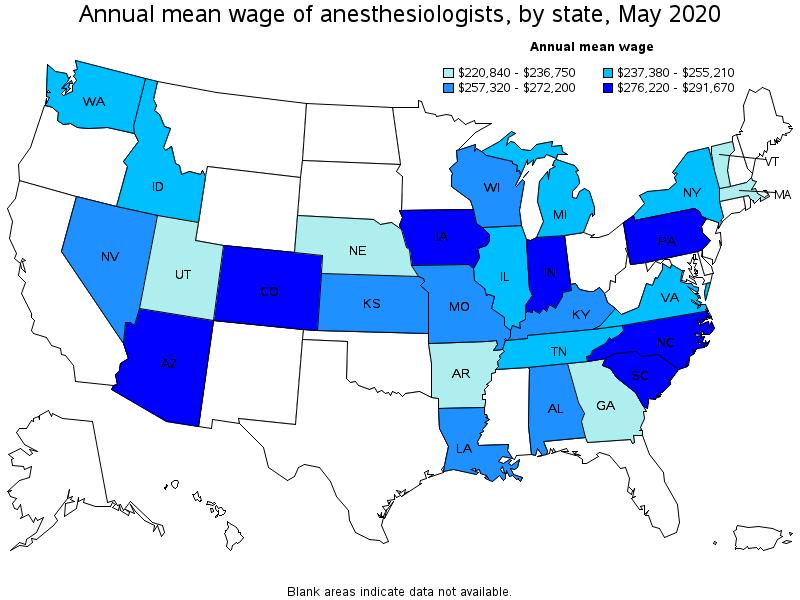
Top paying states for Anesthesiologists:
| State | Employment (1) | Employment per thousand jobs | Location quotient (9) | Hourly mean wage | Annual mean wage (2) |
|---|---|---|---|---|---|
| California | 3,500 | 0.21 | 1.04 | (5) | (5) |
| Connecticut | (8) | (8) | (8) | (5) | (5) |
| Florida | 1,550 | 0.18 | 0.89 | (5) | (5) |
| Hawaii | (8) | (8) | (8) | (5) | (5) |
| Maine | 110 | 0.18 | 0.89 | (5) | (5) |
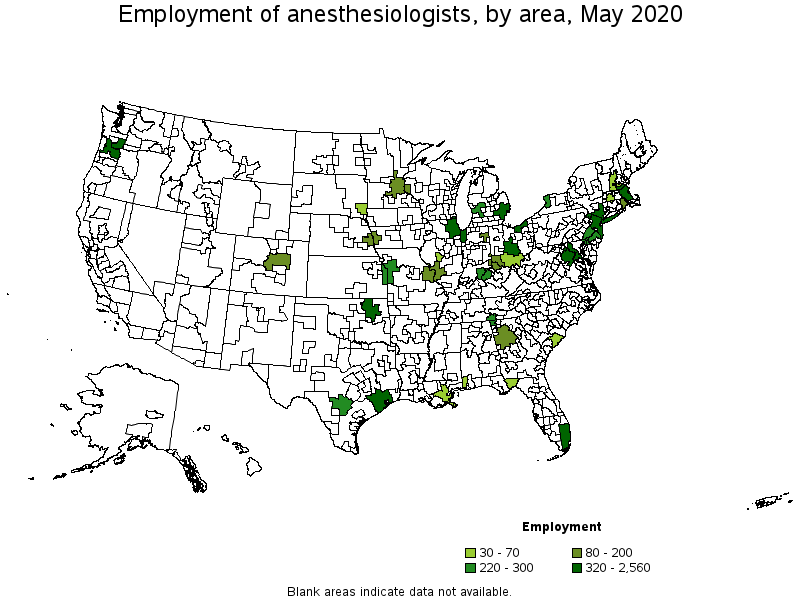
Metropolitan areas with the highest employment level in Anesthesiologists:
| Metropolitan area | Employment (1) | Employment per thousand jobs | Location quotient (9) | Hourly mean wage | Annual mean wage (2) |
|---|---|---|---|---|---|
| New York-Newark-Jersey City, NY-NJ-PA | 2,560 | 0.29 | 1.41 | $ 115.60 | $ 240,440 |
| Washington-Arlington-Alexandria, DC-VA-MD-WV | 1,050 | 0.35 | 1.69 | $ 136.15 | $ 283,200 |
| Houston-The Woodlands-Sugar Land, TX | 960 | 0.32 | 1.57 | $ 119.00 | $ 247,530 |
| Miami-Fort Lauderdale-West Palm Beach, FL | 620 | 0.25 | 1.20 | (5) | (5) |
| Chicago-Naperville-Elgin, IL-IN-WI | 620 | 0.14 | 0.69 | $ 117.48 | $ 244,360 |
| Boston-Cambridge-Nashua, MA-NH | 440 | 0.17 | 0.82 | $ 115.32 | $ 239,860 |
| Portland-Vancouver-Hillsboro, OR-WA | 410 | 0.36 | 1.76 | $ 129.62 | $ 269,610 |
| Columbus, OH | 320 | 0.32 | 1.54 | (5) | (5) |
| Tulsa, OK | 320 | 0.76 | 3.68 | (5) | (5) |
| Cleveland-Elyria, OH | 320 | 0.33 | 1.60 | (5) | (5) |
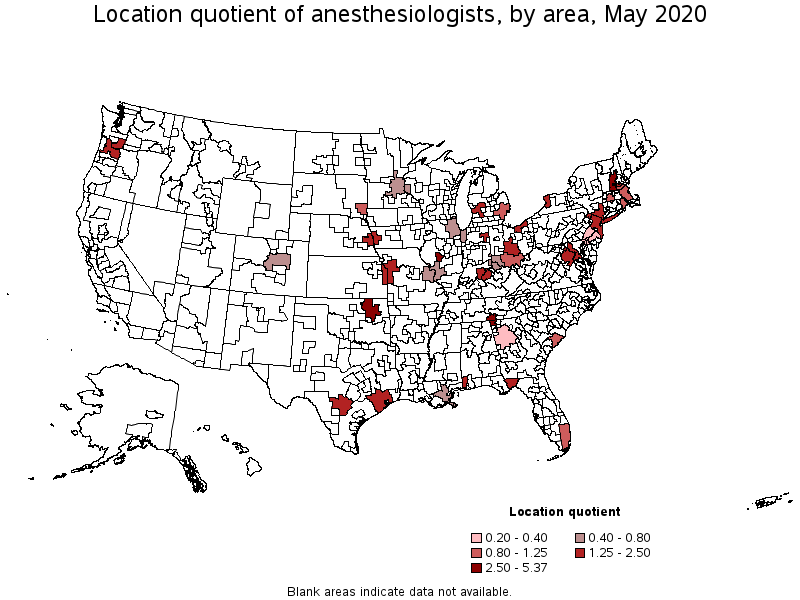
Metropolitan areas with the highest concentration of jobs and location quotients in Anesthesiologists:
| Metropolitan area | Employment (1) | Employment per thousand jobs | Location quotient (9) | Hourly mean wage | Annual mean wage (2) |
|---|---|---|---|---|---|
| Chattanooga, TN-GA | 270 | 1.10 | 5.37 | $ 129.62 | $ 269,610 |
| Tulsa, OK | 320 | 0.76 | 3.68 | (5) | (5) |
| Springfield, IL | 70 | 0.73 | 3.54 | (5) | (5) |
| Louisville/Jefferson County, KY-IN | 300 | 0.48 | 2.35 | (8) | (8) |
| Buffalo-Cheektowaga-Niagara Falls, NY | 220 | 0.43 | 2.11 | (5) | (5) |
| Grand Rapids-Wyoming, MI | 220 | 0.42 | 2.07 | (5) | (5) |
| Fort Wayne, IN | 80 | 0.39 | 1.88 | (5) | (5) |
| Tallahassee, FL | 70 | 0.39 | 1.88 | $ 145.96 | $ 303,600 |
| Manchester, NH | 40 | 0.38 | 1.84 | (5) | (5) |
| Portland-Vancouver-Hillsboro, OR-WA | 410 | 0.36 | 1.76 | $ 129.62 | $ 269,610 |
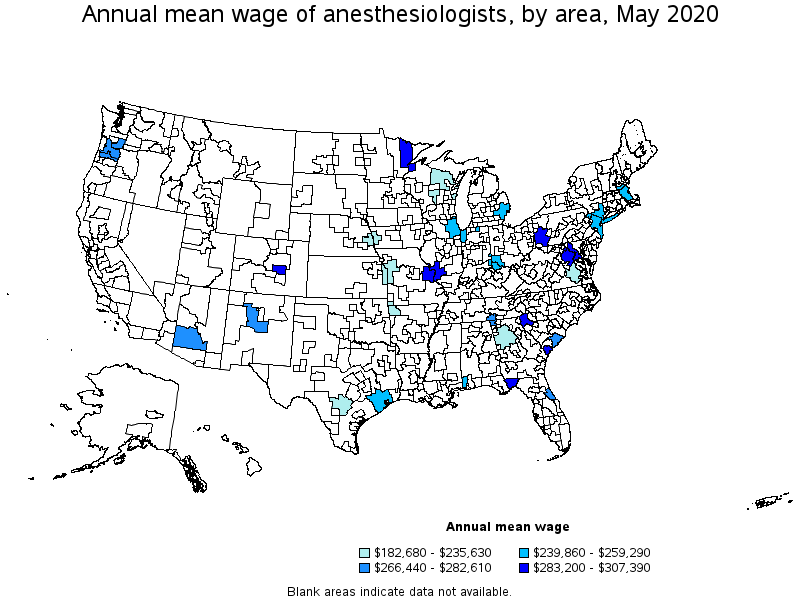
Top paying metropolitan areas for Anesthesiologists:
| Metropolitan area | Employment (1) | Employment per thousand jobs | Location quotient (9) | Hourly mean wage | Annual mean wage (2) |
|---|---|---|---|---|---|
| Buffalo-Cheektowaga-Niagara Falls, NY | 220 | 0.43 | 2.11 | (5) | (5) |
| Cape Coral-Fort Myers, FL | (8) | (8) | (8) | (5) | (5) |
| Charlotte-Concord-Gastonia, NC-SC | (8) | (8) | (8) | (5) | (5) |
| Cleveland-Elyria, OH | 320 | 0.33 | 1.60 | (5) | (5) |
| Columbus, OH | 320 | 0.32 | 1.54 | (5) | (5) |
| Dayton, OH | (8) | (8) | (8) | (5) | (5) |
| Denver-Aurora-Lakewood, CO | 150 | 0.10 | 0.50 | (5) | (5) |
| Des Moines-West Des Moines, IA | (8) | (8) | (8) | (5) | (5) |
| Dothan, AL | (8) | (8) | (8) | (5) | (5) |
| Fort Wayne, IN | 80 | 0.39 | 1.88 | (5) | (5) |
Nonmetropolitan areas with the highest employment in Anesthesiologists:
| Nonmetropolitan area | Employment (1) | Employment per thousand jobs | Location quotient (9) | Hourly mean wage | Annual mean wage (2) |
|---|---|---|---|---|---|
| West Central-Southwest New Hampshire nonmetropolitan area | 70 | 0.76 | 3.69 | (5) | (5) |
| Southern Ohio nonmetropolitan area | 40 | 0.25 | 1.21 | (5) | (5) |
Nonmetropolitan areas with the highest concentration of jobs and location quotients in Anesthesiologists:
| Nonmetropolitan area | Employment (1) | Employment per thousand jobs | Location quotient (9) | Hourly mean wage | Annual mean wage (2) |
|---|---|---|---|---|---|
| West Central-Southwest New Hampshire nonmetropolitan area | 70 | 0.76 | 3.69 | (5) | (5) |
| Southern Ohio nonmetropolitan area | 40 | 0.25 | 1.21 | (5) | (5) |
Top paying nonmetropolitan areas for Anesthesiologists:
| Nonmetropolitan area | Employment (1) | Employment per thousand jobs | Location quotient (9) | Hourly mean wage | Annual mean wage (2) |
|---|---|---|---|---|---|
| Southwest Maine nonmetropolitan area | (8) | (8) | (8) | (5) | (5) |
| West Central-Southwest New Hampshire nonmetropolitan area | 70 | 0.76 | 3.69 | (5) | (5) |
| Eastern Ohio nonmetropolitan area | (8) | (8) | (8) | (5) | (5) |
| Southern Ohio nonmetropolitan area | 40 | 0.25 | 1.21 | (5) | (5) |
| Northeast Oklahoma nonmetropolitan area | (8) | (8) | (8) | (5) | (5) |
These estimates are calculated with data collected from employers in all industry sectors, all metropolitan and nonmetropolitan areas, and all states and the District of Columbia. The top employment and wage figures are provided above. The complete list is available in the downloadable XLS files.
The percentile wage estimate is the value of a wage below which a certain percent of workers fall. The median wage is the 50th percentile wage estimate—50 percent of workers earn less than the median and 50 percent of workers earn more than the median. More about percentile wages.
(1) Estimates for detailed occupations do not sum to the totals because the totals include occupations not shown separately. Estimates do not include self-employed workers.
(2) Annual wages have been calculated by multiplying the hourly mean wage by a "year-round, full-time" hours figure of 2,080 hours; for those occupations where there is not an hourly wage published, the annual wage has been directly calculated from the reported survey data.
(3) The relative standard error (RSE) is a measure of the reliability of a survey statistic. The smaller the relative standard error, the more precise the estimate.
(5) This wage is equal to or greater than $100.00 per hour or $208,000 per year.
(8) Estimate not released.
(9) The location quotient is the ratio of the area concentration of occupational employment to the national average concentration. A location quotient greater than one indicates the occupation has a higher share of employment than average, and a location quotient less than one indicates the occupation is less prevalent in the area than average.
Other OEWS estimates and related information:
May 2020 National Occupational Employment and Wage Estimates
May 2020 State Occupational Employment and Wage Estimates
May 2020 Metropolitan and Nonmetropolitan Area Occupational Employment and Wage Estimates
May 2020 National Industry-Specific Occupational Employment and Wage Estimates
Last Modified Date: March 31, 2021